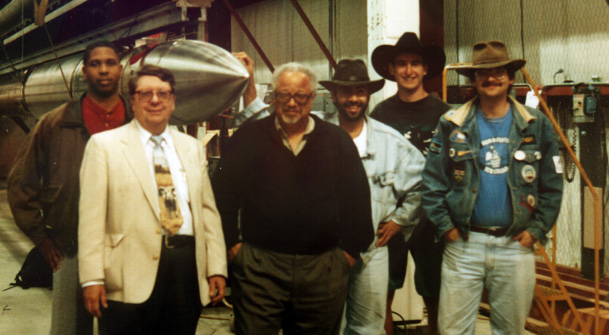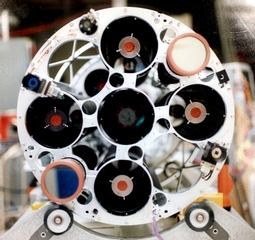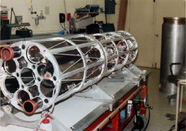 The Multi-Spectral Solar Telescope Array:
The Multi-Spectral Solar Telescope Array:1994 November 3
 The Multi-Spectral Solar Telescope Array:
The Multi-Spectral Solar Telescope Array:

 This is the Front Aperature Plate from the '94 flight. Just about every hole
in the plate has a telescope behind it somewhere. You can see all six
Ritchey-Chrétien telescopes (one is hiding in the back), the two
Cassegrains (one at "2 o'clock" and one at "8 o'clock")
and the two Lockheed SPARCS LISS and MASS.
Would a labled picture help?
This is the Front Aperature Plate from the '94 flight. Just about every hole
in the plate has a telescope behind it somewhere. You can see all six
Ritchey-Chrétien telescopes (one is hiding in the back), the two
Cassegrains (one at "2 o'clock" and one at "8 o'clock")
and the two Lockheed SPARCS LISS and MASS.
Would a labled picture help?
This payload, like the last, was launched atop a Terrier Black Brant IX from the White Sands Missile Range in New Mexico. The telescopes were carried to a peak altitude of about 230km (about as high as the shuttle flies) and remained out of the lower atmosphere for a grand total of five minutes.
 This is a more general view of our payload. In the background, you can
see the "skin" which covers the rear half of the payload.
Unfortunately, I don't have a picture of our payload before it
"landed," but here's one taken afterwards. You may notice that a telescope
that was, at one time, looking out a hole in the FAP is now cocked at a
rather nasty angle. The current guess is that, although the payload was
floating down on it's parachute slowly, the winds had carried it
horizontally at a rather high velocity.
This is a more general view of our payload. In the background, you can
see the "skin" which covers the rear half of the payload.
Unfortunately, I don't have a picture of our payload before it
"landed," but here's one taken afterwards. You may notice that a telescope
that was, at one time, looking out a hole in the FAP is now cocked at a
rather nasty angle. The current guess is that, although the payload was
floating down on it's parachute slowly, the winds had carried it
horizontally at a rather high velocity.
MSSTA is a joint project between NASA/MSFC and Stanford University.